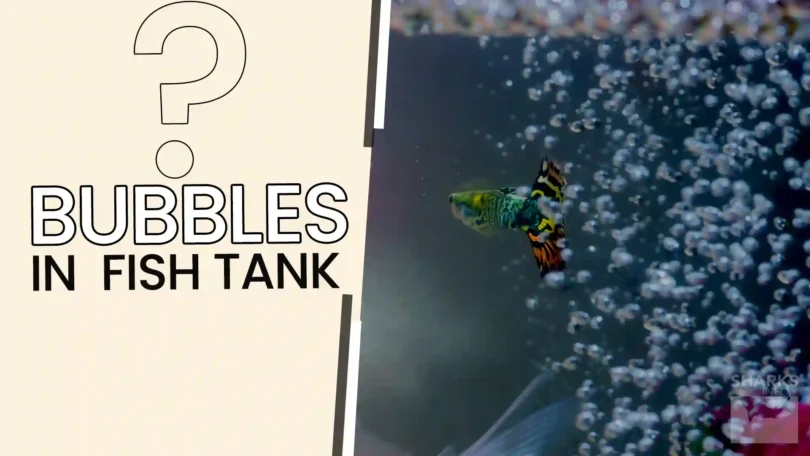If you own an aquarium, you have likely noticed small bubbles appearing in your fish tank. The creation of bubbles in your aquarium occurs in a particular order and isn’t arbitrary. It’s a result of various natural and artificial factors that occur within your aquarium’s ecosystem. While these bubbles can be a common and harmless occurrence, they can sometimes signal issues that require your attention.
This article explores the possible reasons behind why there are bubbles in fish tanks and provides practical tips on maintaining a healthy aquatic environment for your fish.
What do bubbles in my fish tank mean?
When you notice bubbles in your fish tank, they can indicate several different scenarios, most of them soothing, but some can be cause for concern. The bubbles can have diverse sources, and their understanding is vital to uphold the well-being of the aquatic environment.
1: Oxygenation
Oxygenation in the water is one of the primary reasons behind the formation of bubbles in your fish tank. When there is a disturbance on the water’s surface, it allows air to enter the water, leading to the creation of bubbles. This process, known as aeration, can occur when the water from a filter pours back into the tank, creating a waterfall effect that introduces oxygen into the water.
These bubbles are generally beneficial for your fish tank as they increase the dissolved oxygen level in the water.
2: The Effect of Water Movement
The addition of fresh water to your fish tank can also trigger the formation of bubbles. As the water fills and disturbs the existing tank water, the air gets trapped and forms bubbles. Similarly, temperature changes in the water can cause dissolved gasses to form visible bubbles. Typically, these bubbles are harmless and should disappear in a couple of hours.
Why are there bubbles in my fish tank?
The phenomenon of bubbles in your fish tank extends beyond the simple factors of oxygenation and water movement. It delves into the complex world of gas exchange and how it influences the underwater environment of your aquarium.
1: Oxygen and Carbon Dioxide Balance
Fish, like humans, need oxygen to live. They extract oxygen from water, replacing it with carbon dioxide. This process creates an equilibrium of gas exchange, which sometimes results in visible bubbles.
2: Temperature Impact on Gas Exchange
Temperature plays a crucial role in this gas exchange. Warmer water holds less dissolved oxygen and more dissolved carbon dioxide, leading to more bubbles.
The Potential Dangers of Bubbles
While bubbles in your fish tank are often a result of harmless natural processes like oxygenation or water movement, they can sometimes indicate the presence of harmful gasses.
1: Ammonia Build-Up
While ammonia doesn’t create bubbles, overfeeding and decaying organic matter can lead to its formation. This toxic substance is harmful to fish, and a spike in its level can indicate a water quality problem that might also be contributing to bubble formation.
2: Nitrogen and Nitrite Levels
Nitrogen, a common component of air, is typically harmless to fish. However, when organic waste builds up in your tank due to overfeeding, plant decay, or fish waste, anaerobic bacteria can break it down through denitrification, producing nitrogen gas. The gas forms bubbles in the substrate, posing a risk to fish if bubbles get lodged in their gills, potentially leading to gas bubble disease.
Be vigilant about these levels and confirm that your filtration system is functioning adequately.
3: Hydrogen Sulfide
Hydrogen sulfide, a lethal gas for fish, forms in oxygen-deprived environments with accumulated organic waste. Bubbles can form from this gas, which releases a foul odor when they burst at the surface.
Tips to manage bubbles in your fish tank
- Regular water changes are a fundamental part of keeping your fish tank clean and ensuring the water quality remains high.
- Feeding your fish too much can result in surplus food waste, which, upon decomposition, could potentially cause gas to form.
- Feed your fish only what they can consume in a few minutes, and ensure no food debris is left floating in the tank or sinking to the bottom.
- An effective filtration system will not only help oxygenate the water but also reduce waste buildup.
- Keep an eye on your tank’s temperature. Warmer water holds less gas than cooler water, so a sudden increase in temperature could lead to the formation of gas bubbles.
Conclusion
While bubbles in your fish tank may not necessarily signal a crisis, they should prompt a keen eye for observation. Bubbles often result from natural processes like oxygenation or water movement, which are generally beneficial for your aquatic friends. However, in certain circumstances, they can also signal potential problems, such as overfeeding, water quality issues, or the presence of harmful gasses.
Whether a natural occurrence or a sign of a potential issue, understanding what these bubbles signify allows you to ensure a healthy, thriving habitat for your aquatic pets.







